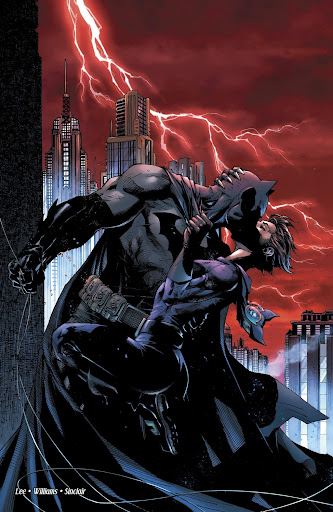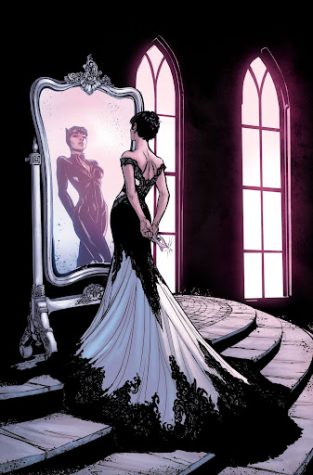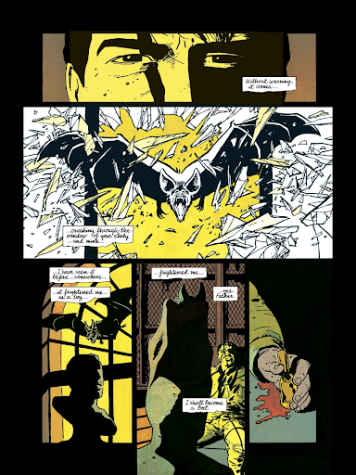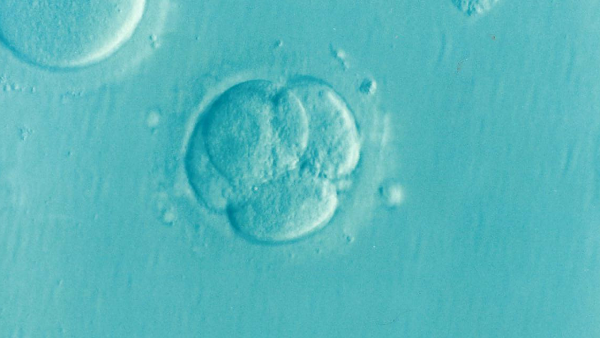The Bat And The Cat Has A Nice Ring To It

Photo courtesy of Jim Lee
Recently, I’ve been mega excited for “The Batman,” which is set to release in early March, so I’ve been craving for some Batman stories. I decided to re-read “Batman: Hush” and some of Tom King’s run on “Batman.”
In my opinion, these are two of the quintessential Batman stories for comic fans to read. That is a bit of a controversial statement, considering they have to compete with classic books such as “The Killing Joke,” “The Dark Knight Returns,” “The Long Halloween,” and “Batman Year One,” along with more recent seminal works by Scott Snyder and Grant Morrison.
For the most part, I firmly believe that “Hush” and King’s run firmly stand alongside these quintessential stories, because they comment a lot on Batman as a character and his psyche, which isn’t something that’s deeply explored in a lot of his classic stories. That’s not necessarily a bad thing, as stories like “Year One” and “The Long Halloween” place Gotham more as the main character rather than Batman, but these two stories do a lot to place the reader into the tortured mind of Bruce Wayne.
The reason I love these books is that the central conflict isn’t necessarily Batman having to defeat the villain.
The conflict is much more personal and internal to Bruce Wayne. In both “Hush” and King’s run, the relationship between Batman and Catwoman is central to each story. Personally, this is my favorite fictional romance, because I feel like this speaks to the fundamental core of each character. It serves a deeper purpose than just two star-crossed lovers who couldn’t imagine their lives without each other and more so two people overcoming the emotional damage and trauma they endured in their childhoods.

We all know the origin of Batman, but a lot of people don’t know the extent to which the death of his parents affected him. We know it was enough to drive him to dress up as a bat and fight crime, but rarely do we see how he felt as a child after that night. Bruce grew up as a disturbed child. He grappled with debilitating depression and suicidal thoughts throughout his childhood and into his early adult years.
Because of this, he closed himself off to almost any human connections outside of Bruce’s butler and father figure, Alfred, and the occasional friend such as (fun fact) childhood friend, Zatanna, who becomes a fellow superhero and leader of the magical counterpart of the Justice League, Justice League Dark (original name, I know).
In his early years as Batman, Bruce was an angry and vengeful recluse who was distrusting of others. Many view this as the way Batman should be and dislike him building an enormous supporting cast of Bat-Family members and joining the Justice League. In my opinion, this is a massive misread of the character. The purpose of introducing the Justice League and his battalion of sidekicks and allies, including Catwoman, is to slowly break down the walls and preconceptions Bruce had built up since his childhood.
It’s a way of showing how Bruce is overcoming the trauma of his past and not only to love and trust others, but also to be happy. This is shown most prevalently (ironically) when he is faced with the death of one of his friends or allies.
When Damian Wayne, Bruce’s biological son, died, Bruce became more violent and brutal than ever and started using the mantle as a way to vent his sadness and anger for the loss of his son, and even fought his way through one of the most dangerous places in the universe and fought Darkseid single-handedly to get his son back. Batman isn’t just a way for Bruce to overcome the guilt of his parents’ deaths, but is also what eventually connects Bruce to the rest of humanity.

Catwoman’s origin is a little more niche and not well-known.
Most people would refer to the origin of Michelle Pfeiffer’s Catwoman in the 1992 movie “Batman Returns” but that origin couldn’t be farther from her true origin, which is a lot more emotional and tragic. At a young age when Selina came back from school, she found her mom dead in the bathtub from suicide.
This drove her father to become a depressed alcoholic who would abuse and mistreat Selina because of how much she looked like her mother. Eventually, he too died by drinking himself to death, which left Selina and her sister, Maggie Kyle, orphans.
This is where some origins start to differ because in the 1993 Catwoman run by Jim Balent, she gets sent to an orphanage, eventually escapes, and becomes a cat burglar, who eventually accrues enough wealth to become a part of high society.
Conversely, Frank Miller’s “Batman Year One” takes a much darker turn for the character, as she starts as a sex worker on the East End district in Gotham. Nevertheless, she ends up as Catwoman after coming into contact with Batman, but more on that later. Because of the traumatic events of her past, Selina also becomes detached in a similar way to Bruce.
She becomes selfish and distrusting with only a few meaningful human connections, with those being Maggie and her friend Holly Robinson. Selina at first uses Catwoman as a way to keep the world at arm’s length because of the repeated trauma and abuse in her past, but eventually, like Batman, uses her persona more for good and becomes almost like a Robin Hood figure for the East End.
It is important to mention though the problematic creation of the character. For many years Catwoman was solely just eye candy for male audiences and it wasn’t until Frank Miller’s “Batman Year One” and Ed Brubaker’s “Catwoman of East End” that she became a truly fleshed-out character with her own goals and motivations.
“I felt that women were feline creatures and men were more like dogs,” said Batman and Catwoman co-creator Bob Kane. “While dogs are faithful and friendly, cats are cool, detached, and unreliable. I felt much warmer with dogs around me, cats are as hard to understand as women are. Men feel more sure of themselves with a male friend than a woman. You always need to keep women at arm’s length. We don’t want anyone taking over our souls, and women have a habit of doing that. So there’s a love-resentment thing with women. I guess women will feel that I’m being chauvinistic to speak this way, but I do feel that I’ve had better relationships with male friends than women. With women, once the romance is over, somehow they never remain my friends.”
Her creation was that from a sexist and chauvinistic view, but thankfully modern comics give her proper depth and character that she lacked before. Sadly, this doesn’t go to all adaptations because most of the time she’s reverted to the same misogynistic tropes of the past, outside of the comics such as in “Batman Returns,” “The Dark Knight Rises,” “Batman Arkham City,” and “Injustice.”

In what’s considered the definitive Batman origin story, “Batman Year One”, Bruce and Selina indirectly lead each other to become both Batman and Catwoman. Because of Selina’s intervention when Bruce gets into a fight on the East End, he gets mortally wounded, which leads to the iconic scene where Bruce says, “Yes, Father, I shall become a bat.” Bruce’s public notoriety subsequently inspires Selina to leave sex work and to become Catwoman.
Despite interacting only once throughout the entire book and not having a single line of dialogue together, both characters have a profound effect on each other. It’s a cool detail to have each character be essential to each other’s origin establishing how important they are to each other without any emotional bond formed yet.
Ok, so now that I’ve explained the roots of both characters, why do I find their relationship so engaging? Why is it better than any other superhero relationship?
It’s because it has become integral to the core of both characters and something that reflects their growth across the decades.
Both characters have had other love interests across the years, with some major ones for Bruce being Kathy Kane, Silver Saint Cloud, Andrea Beaumont, Jezebel Jet, and most famously Talia al Ghul. It’s not like Bruce has had a lack of love in his life, but what makes his relationship with Selina click more than the others is that she is the only one that truly grasps and understands the vigilante lifestyle he lives.
The only person who comes close is Talia al Ghul, but since Grant Morrison wrote the character, she has become more of a villain/antihero role for Bruce, along with her conflicts with Bruce about his moral code souring their relationship. Selina actually knows and understands his life because it’s one she also lives just under different circumstances. Even when the two are separated and in different relationships the two still matter a lot to each other. In “Heart of Hush,” Bruce, despite currently dating Jezebel Jet, admits to what he thought was an unconscious Catwoman that he never stopped loving her, following their split at the end of the “Hush” storyline.
Despite what edgelords and sometimes even DC might say, the story of Batman, and by extension Catwoman, isn’t one of vengeance, justice, or tragedy. Rather, it’s the story of this sad and lonely child that is Bruce Wayne learning to fix the hole that was left by the death of his parents.
As I said before, a lot of people prefer Batman to be more of a lone wolf with a list of allies you can count on one hand, but this is a fundamental misread of the character. From the very first issue of “Batman” in 1940, he’s had Robin, Selina Kyle, and Jim Gordon as a core part of his mythos. Both characters famously have an on and off again relationship, which may upset some readers or fans reading them for the first time, but when it’s done well, it has a really powerful effect.
The reason it works is because that on and off-again relationship is a result of one of them being afraid or unable to let the other in, so their being able to be in a committed relationship signifies how much they’ve grown over their careers. All these issues with trust and abandonment are a result of their childhood trauma, so their being able to finally move past it together is a powerful commentary on if they can truly be happy despite being vigilantes with horrible childhood trauma.
While Batman is often listed as a tragic character because of the copious amount of horrible things he endures, his whole character is seeing past the dark. At its core, the story of Batman is about him finding humanity in those around him. It’s why he joins the Justice League, builds the Bat-Family, starts numerous superhero teams, and loves Catwoman. “I believe Master Bruce is almost as obsessive about family as he is about preventing crime,” said Alfred Pennyworth in the story “A Lonely Place of Dying.”
Batman and Catwoman are two characters that perfectly bounce off each other. Both characters inspired the other to take up the respective mantles, and after years of development starting in 1940, their relationship has become one of the most engaging in comics. They are characters that had horrible traumatizing experiences but despite that, they learn to live and love.
They overcome their respective trauma with the help of others and each other and that is something that I find to be more powerful than almost any other relationship.
“After the alley, the pearls… I… I was a child. That…I thought was the end. I was the end. I went to…to kill myself with a knife. Instead, I took a vow. I killed myself with a vow. I was on my knees. “I swear by the spirits of my parents to avenge their deaths by spending the rest of my life warring on all criminals.” I lived by that vow. I was the vow I was Batman. I am no longer a child. Life is not a trap you make when you’re ten and you’re hurting. Life is a choice you make every day. Every damn day. I choose her. I choose happiness. I chose family. And I choose Batman.”
– “Batman” by Tom King issue 85.












Kate Brandes • Feb 14, 2022 at 1:00 pm
Good stuff, AJ. Glad to see you writing here, again.